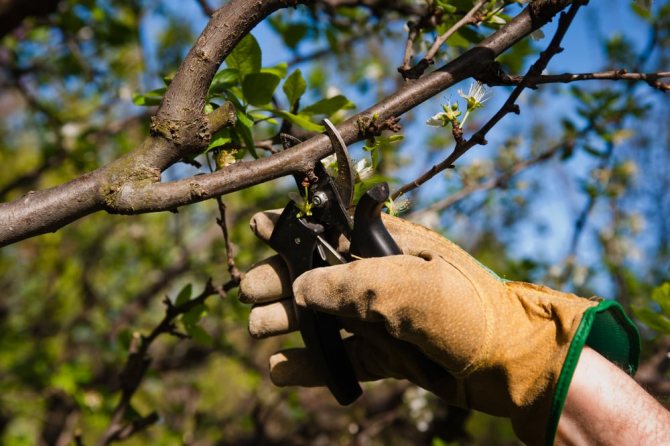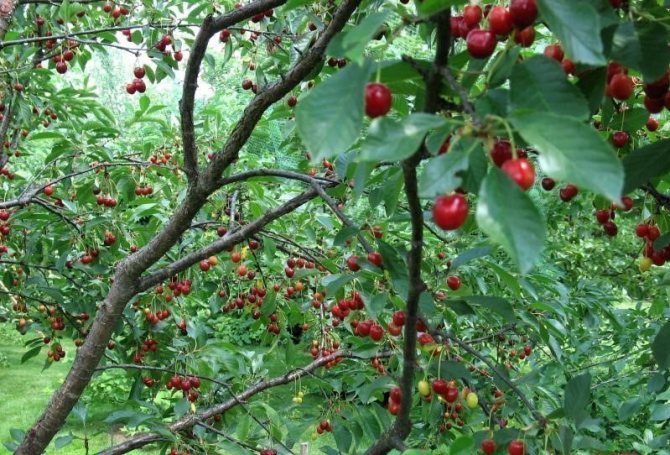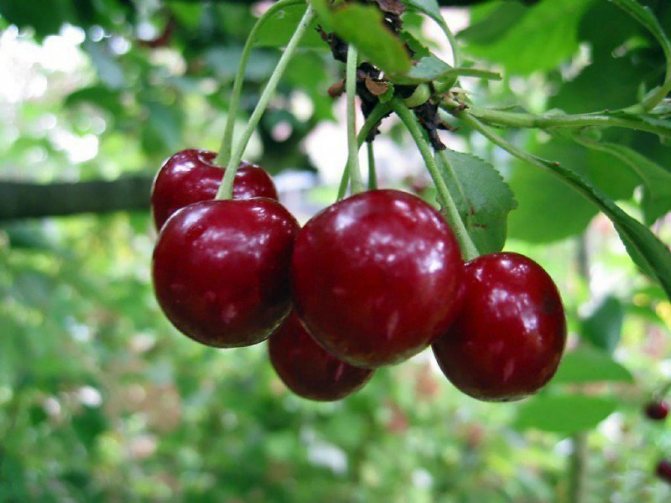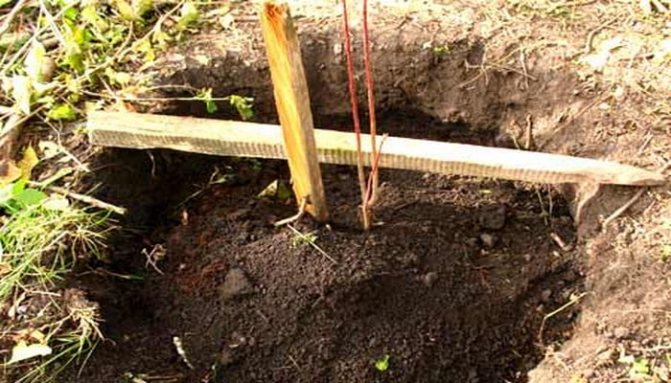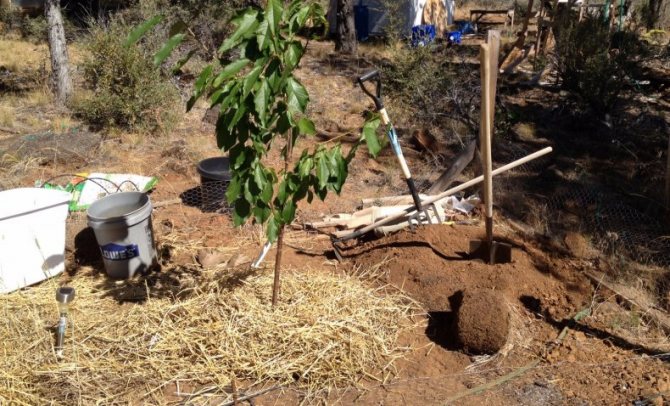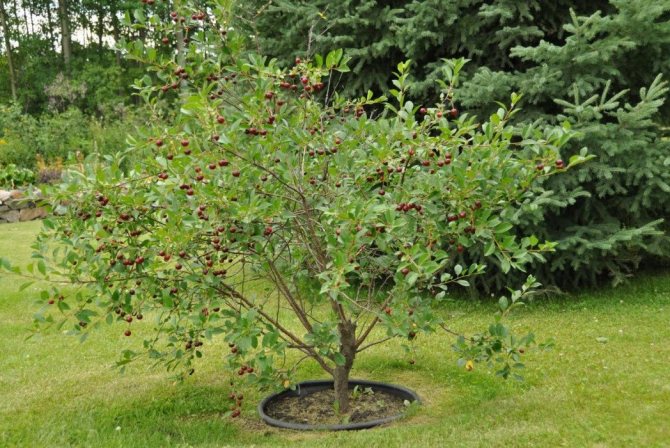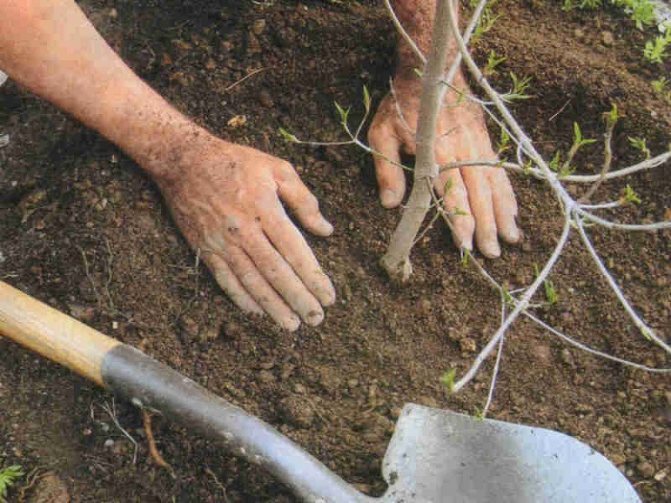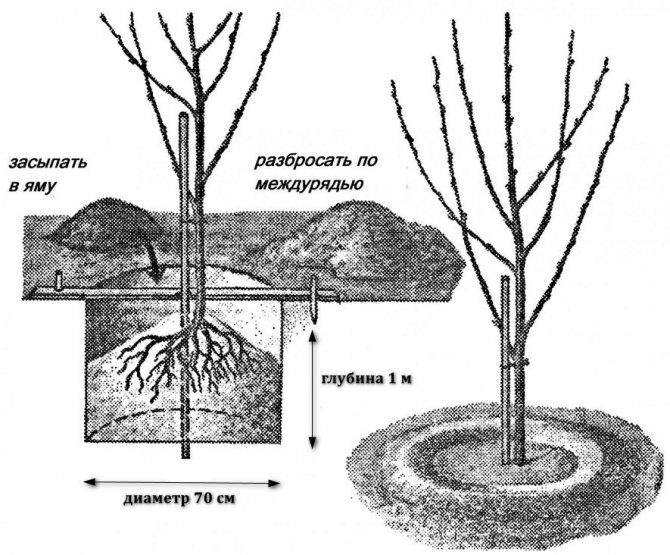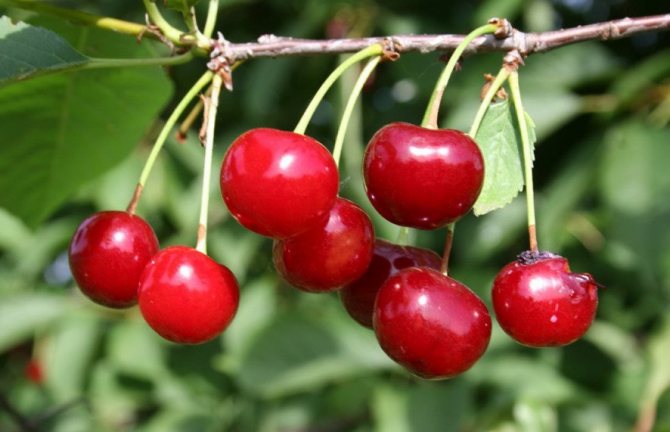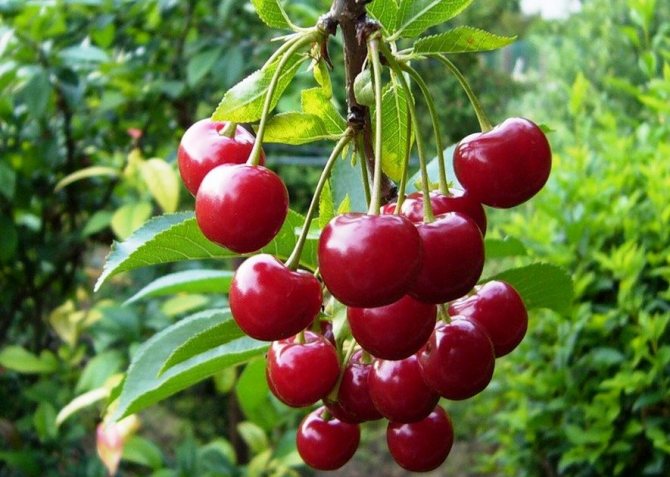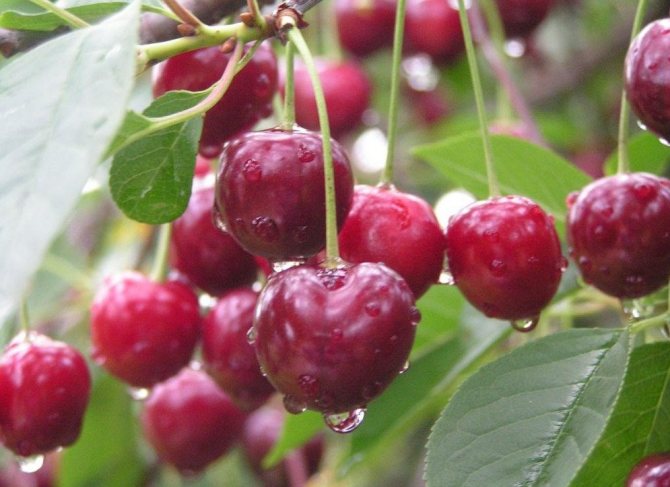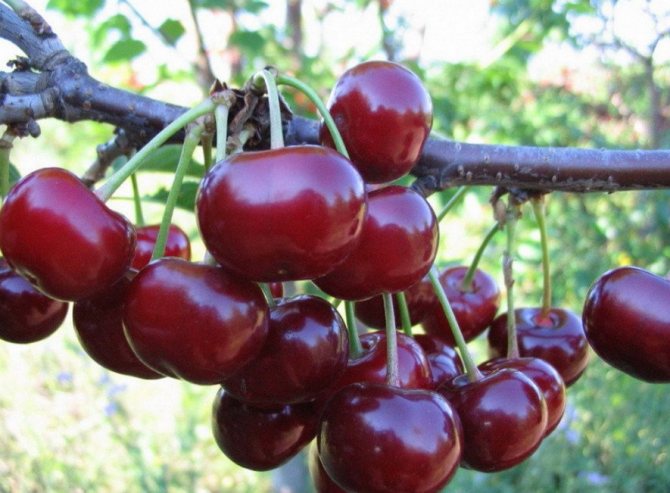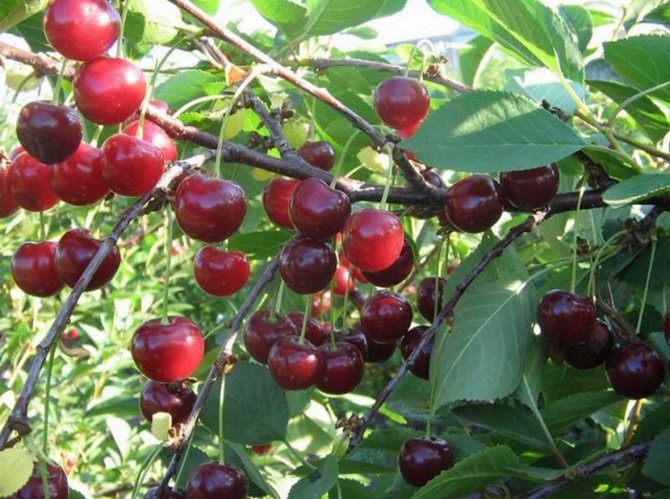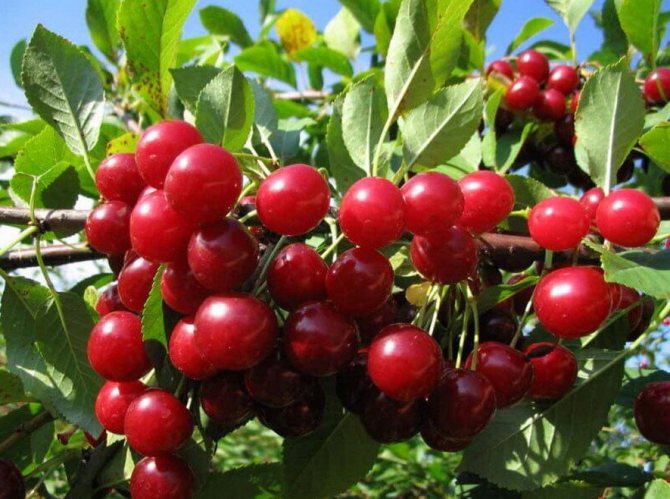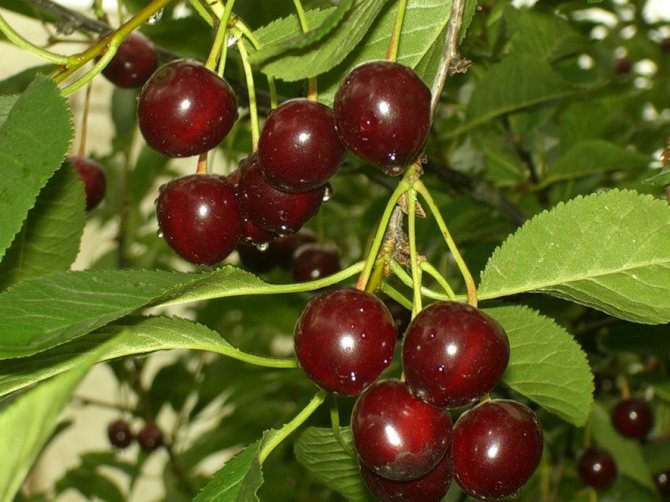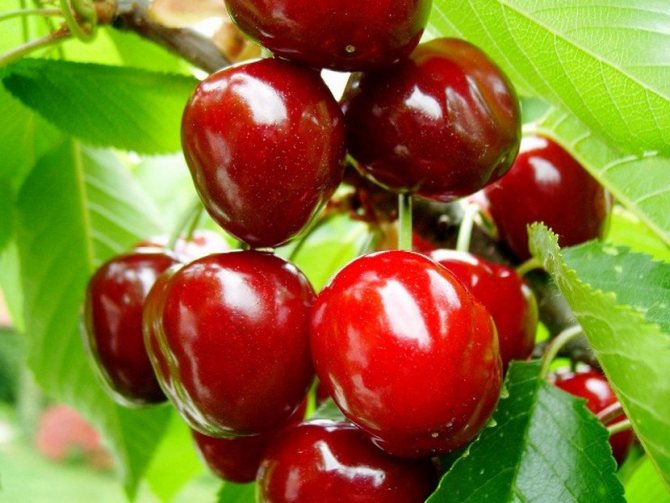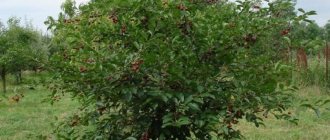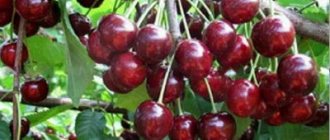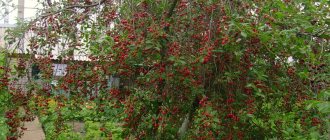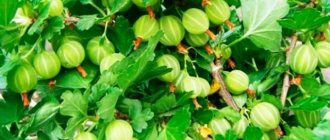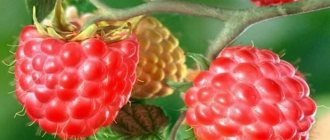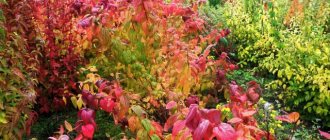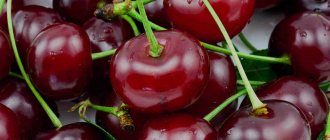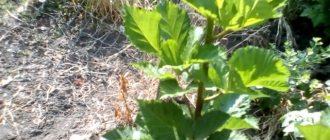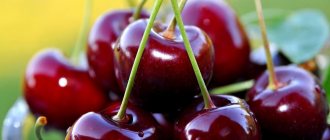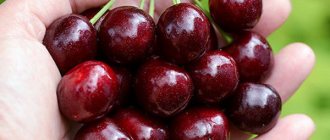Description
The tree is small, shrub type, height - 2.5 - 3 meters. The crown is rounded, not too thickened, its constituent branches become bare and droop with age. Shoots are thin. The bark of young shoots is red-brown, smooth and slightly shiny, covered with light, medium-sized lenticels. The bark on old branches has a grayish tint. The buds grow slightly deviating from the shoot. Cherry leafiness is moderate. The leaf blade of Apukhtinskaya is ordinary, light green, with reticular veins. The shape of the leaf is elliptical, the edge is serrate. The surface of the plate is smooth, slightly shiny. The leaves are slightly folded along the central vein. The petiole is ordinary; at its base, an anthocyanin coloration sometimes appears faintly. One or two glands are present, they are small, unpainted. The flowers are white, five-petalled. The ovary of the variety is most often formed on annual growths.
Fruits are medium in size, one-dimensional, weighing 3.3 - 3.5 grams. Drupes are round-heart-shaped, dark red. The funnel is wide and shallow. The skin is thin, glossy. The pulp is moderately dense, juicy, tender, red in color. The taste is classic, rather sour, with a slight astringency, pronounced cherry aroma. Most gardeners assess the taste as mediocre, but this opinion is rather subjective, because the taste largely depends on the region of cultivation and the degree of lighting. The stone is large, oval, takes 12% of the total mass of the berry, it is easily separated. The peduncle is thin and long, firmly attached to the fruit. Semi-dry separation.
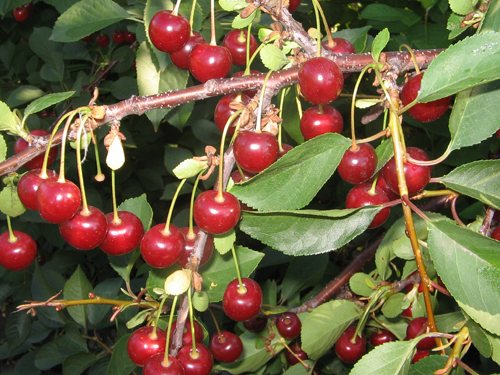
Common cherry 'Apukhtinskaya'
Latin name: prunus cerasus ‘apuhtinskaya’
Main type: Common cherry
| Fruit size |
|
| Fruit shape |
|
| Fruit color | |
| Winter hardiness |
|
| Decorativeness of plants and fruits |
|
| Flower size |
|
| Brush characteristic |
|
| Berry / brush separation |
|
| Nut kernel size |
|
| Blush (top color) |
|
| Fruit pulp color | |
| Density and character of the pulp (fruit / bush / yag) |
|
| Fruit aroma |
|
| Frost resistance (fruit / bush / yag) |
|
| Drought resistance (fruit / bush / yag) |
|
| Beginning of fruiting after planting |
|
| Ripening period (fruit / bush / yag) |
|
| Consumer maturity |
|
| Productivity (fruit / bush / yag) |
|
| Fruit crumbling |
|
| Remontant |
|
| Self-fertilized / self-fertile |
|
| Purpose of fruits (fruit / bush / yag) |
|
| Fruit taste (fruit / bush / yag) |
|
| Requirements for soil ph (fruit / bush / yag) |
|
| Shelter for the winter (fruit / bush / yag) |
|
| Soil type (fruit / bush / yag) |
|
| Disease resistance (fruit / bush / yag) |
|
| Pest resistance (fruit / bush / yag) |
|
| Habitus (fruit / bush / yag) |
|
| Growth shape |
|
| Crown density |
|
| Thorns, thorns |
|
| Vitamin content (fruit / bush / yag) |
|
| Keeping quality of fruits (fruit / bush / yag) |
|
| Cultivation region by originator (fruit / bush / yag) |
|
Expand all properties
Description of the plant:
Vishnya ordinary ‘Apukhtinskaya’ is presumably a spontaneous somatic mutant (clone) of ‘Lotovaya’ variety. Found in the village of Apukhtino, Odoyevsky District, Tula Region, where it is widespread in its own-rooted culture. Perspective.
Recommended for testing in the Northwest and Central regions.
Size and shape of growth:
The common cherry 'Apukhtinskaya' is represented by trees of low height, the crown is drooping. Growth type - bushy.
Fruiting mainly on annual branches.
Flowers and fruits:
Fruits are of medium size, 3.6-4.0 g. The shape is rounded-heart-shaped. The funnel is wide and shallow. The skin is firm, dark red. The peduncle is long, thin, firmly attached to the fruit.
The pulp is dark red, juicy, tender. The taste is sour. The stone is medium in size, oval.
Early maturity, ripening time, productivity:
The variety is mainly for technical purposes, highly self-fertile. Very late ripening. The yield is plentiful, annual.
Winter hardiness:
Disease resistance:
Vishnya ordinary ‘Apukhtinskaya’ is weakly affected by coccomycosis.
Characteristics
- Apukhtinskaya has excellent early maturity. In the period of fruiting begins 2 - 3 years after planting. And after vaccination, it can bring the first berries the next year;
- late-ripening variety, the harvest ripens in the second half of August;
- cherry yield is good, increasing over the years. According to some reports, 10 to 15 kg of berries are harvested from a 5-year-old tree;
- fruiting is stable, annual;
- the fruits hold firmly on the branches during the ripening period, do not fall off for a long time;
- the variety is considered highly self-fertile, so the harvest is tied even without pollinators. By the way, it is difficult to pick up a pollinator due to the late flowering of Apukhtinskaya, which occurs in June;
- according to reviews, cherries are distinguished by good winter hardiness and drought resistance in regions suitable for growing;
- the immunity of the variety is above average. According to some reports, it tends to be affected by coccomycosis;
- the transportability of Apukhtinskaya fruits is low, since the stalk is separated along with the skin and provokes juice production;
- the way of using drupes is technical. The fruits are great for all types of processing and canning. But some people really like the taste of this cherry in its natural form.
Harsh winters of the Moscow region
As noted above, winters in the Moscow region are quite harsh, moreover, such disasters as icing often occur. Therefore, cherry varieties for the Moscow region must have:
- good frost resistance - in order to withstand such a low temperature regime;
- winter hardiness - to endure sharp frosts or icing.
As mentioned above, winters in the Moscow region are quite harsh, often there are such disasters as icing. In this regard, cherry varieties for this region must have:
- good frost resistance - needed to be able to withstand such a low temperature regime;
- winter hardiness - necessary to endure sudden frost or icing.
Planting and leaving
It is recommended to plant 2-year-old seedlings. For breeding, it is best to use self-rooted plants. The right time for planting is autumn, about 3 weeks before the onset of persistent cold weather. During the preparation of the planting pit, nutrients are introduced - phosphorus-potassium fertilizers and organic matter, for example, well-rotted manure. The next feeding is carried out only after 2 years. Watering is moderate, the roots do not tolerate high soil moisture. It is imperative to carry out preventive spraying against diseases and pests. A well-lit place for planting is selected so that the amount of sugars in the berries increases.
Apukhtinskaya has established itself as a reliable and undemanding variety.Fruiting of the plant is annual and good, so the winter table will not remain without tasty preparations - jam, compotes, jam, jam. Cherries are also good in their own juice. And the small size of the tree makes it easy to care for.
Varieties and varieties of zamioculcas of the species zamielistny (with photo)
Zamioculcas zamielistny (Z. zamiifolia);
Zamioculcas lanceolate (Z. lanceolata);
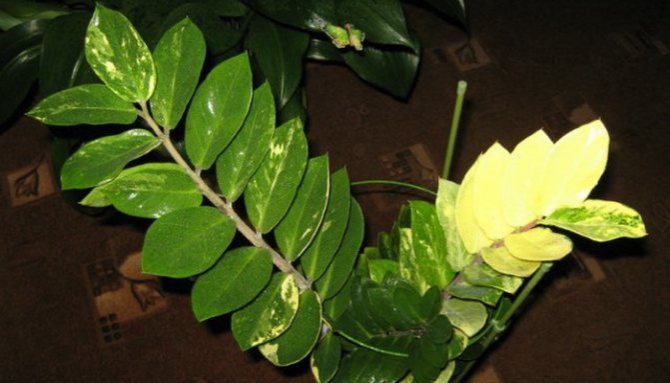

Zamioculcas variegated (Z. variegated).
It is interesting for novice plant breeders to know how zamiokulkas blooms in nature and at home? The flowering of zamiokulkas in nature is a rare phenomenon, since it happens only at a very mature age. In room culture, under appropriate conditions of maintenance, good care, the plant blooms with white and light cream flowers, but already at a fairly old age.
The inflorescence is an ear. Flowers of different sexes are located separately on the cob, female - from below, male - from above, and between them there is a zone of sterile flowers. Due to this structure of the inflorescence, its self-pollination is impossible. In nature, the succulent is pollinated by wind or crawling insects that live in the plant's homeland.
The photo shows how the zamioculcas blooms: inflorescences consisting of an ear and a veil, which appear at the very base of the leaves at a very old age of the plant.
In room culture, the zamioculcas flower is quite unpretentious, and how to care for it is described below. In order to provide zamiokulkas with favorable growing conditions, you should know the features of the environment of its existence.
Zamioculcas requires bright diffused light, but it also tolerates partial shade, therefore it grows well on the northern window. With a sufficient amount of light, it grows faster and retains the brightness of its colors. In a dense shade, the growth rate of zamiokulkas will slow down, the leaves will weaken, and there will be fewer of them on the trunk.
Characteristics of the variety
The name of the variety is associated with the place of origin - the village of Apukhtino. At the moment, it is not included in the State Register, although it has been cultivated in the gardens of Russia for many years. Differs in good frost resistance and unpretentiousness. Suitable for growing both in the Moscow region and in more northern regions.
Apukhtinskaya cherry is self-fertile, and even if there is only one tree in the garden, it is capable of bearing fruit.
To increase the yield and quality of fruits, it is recommended to grow in the vicinity of such late varieties as:
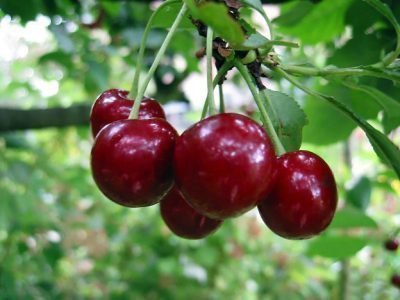

Cherry Molodezhnaya increases the yield of the Apukhtinskaya variety
Wood
The tree of this cherry variety is classified as medium-sized, up to 3 m high. In appearance it looks like a bush, the trunk is short, the skeletal branches are well developed. The crown is not thickened, drooping with open branches of medium thickness. Requires regular pruning. The branches are covered with small (up to 6 cm in length) leaves of a dark green color.
The tree blooms in early June with snow-white five-petal flowers. Due to the late flowering, the ovaries rarely freeze over. Cherry varieties Apukhtinskaya enter the fruiting stage in the second year after planting.
Fruit
The fruits begin to ripen in August. Ripening is gradual, but the cherries do not crumble, and the entire crop can be harvested in one go. With good care, more than 20 kg of cherries can be harvested from one tree.
Characteristic differences between fruits:
- heart-shaped, slightly flattened shape;
- the skin is dark red, thin;
- the pulp is dense, homogeneous, red;
- average weight 3.5 - 4 g;
- the taste is predominantly sour;
- rich cherry aroma;
- the bone takes up no more than 12%, it separates well.
The fruits of this variety are ideal for technical processing. They make aromatic jam. When dried, it retains its bright color and rich aroma. The fruits of the Apukhtinskaya cherry are also suitable for freezing.
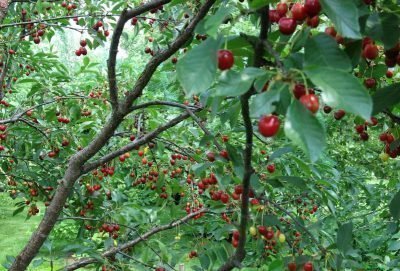

Cherry fruits of the Apukhtinskaya variety are used to make jam
Stages
For planting cherries, you need to prepare a pit 80x60 cm in size.If you plan to plant more than one tree, the distance between them should be at least 3 m.You need to add a nutrient mixture to the planting pit:
- 15 kg of compost;
- 50 g superphosphate;
- 0.5 kg of wood ash;
- top layer of fertile soil from the pit.
All components are mixed and placed in a slide on the bottom. If the soils are clay, then add ½ bucket of sand to the mixture.
In the center of the hole, you need to install a wooden even support, which will help fix the young cherry trunk. The roots of the seedling are evenly distributed in the planting pit and gradually filled with soil. It is necessary to ensure that the root collar is not buried and remains on the surface.
It is necessary to lightly trample the ground around the trunk, and then gently pour water over it, trying not to erode the soil. When the water is absorbed, the trunk circle is mulched with straw, peat or sawdust. After landing, the trunk is attached to the support in several places. You can install a protective net around the trunk to protect young seedlings from rodents.
Proper care is essential for a rich harvest and the well-being of the tree. Basic care consists of:
Watering
Cherries are sensitive to improper watering. Both overflow and lack of moisture during long periods of drought will negatively affect its development.
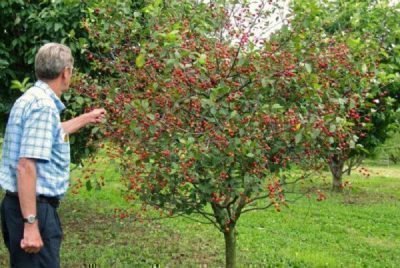

Cherry varieties Apukhtinskaya are sensitive to improper watering
Regular watering is especially important in the first 2 years after planting the seedlings. Young trees are watered once a week during drought. For one tree, 20 liters of water will be enough. It is better to do this in the morning or in the evening.
Already fruiting, mature trees are more drought tolerant. But the lack of moisture during the period of formation, ovary and filling of fruits can affect the quality of the fruits. To do this, it is convenient to make a shallow groove around the trunk at a distance of 30-40 cm and pour 2-3 buckets of water into it at least once a week.
Pruning
Apukhtinskaya cherry lends itself well to crown formation and easily tolerates pruning. The pruning procedure is carried out in early spring before the juice starts to move and buds open. This variety can be formed both as a tree and as a bush. Formation begins in the first year after planting.
In addition to formative pruning, sanitary is also carried out, it consists in annual pruning:
- overgrown on the trunk;
- weak and dry branches;
- branches that have grown into the middle and thicken the crown;
- skeletal branches 1/3 of the length.
Such pruning will improve the ventilation of the crown, stimulate the growth of new shoots and the rejuvenation of the tree.
Top dressing
The first year after planting, the cherry seedling does not need feeding - the fertilizer applied to the planting pit will be enough to ensure full growth. In subsequent years, top dressing is applied several times per season:
- In the spring, before flowering, cherries are fed with nitrogen-containing fertilizers. For this, carbamide (urea) or ammonium nitrate is suitable. They are used in dissolved form (30 g / 10 l of water). One tree needs 10 liters of solution, they are watered with a near-trunk circle on moistened earth.
- After flowering, organic fertilizers are applied. They act faster and more efficiently in liquid form. For such a top dressing, slurry is prepared. Dissolve 1 cup of manure in 10 liters, you can add 30 g of superphosphate and water around the tree.
- During the ripening period of cherries, trees are sprayed with a carbamide solution (20 g / 10 l of water). This will ensure intensive fruit growth.
- After flowering, the cherries need to be fed with phosphorus-potassium fertilizers. For this, wood ash or bone meal (250 g / wood) is suitable.
- In late autumn, after the leaves fall off, the trunk circle is mulched with ripe manure or vegetable peels.
Pests and diseases
An important role in the successful cultivation of cherries of the Apukhtinskaya variety is played by prevention and protection against diseases and pests.
| Name | Time of processing | A drug | Dosing, for 10 l of water |
| Monoliosis, cocomycosis | At the beginning of flowering and opening of leaves | Bordeaux mixture | 200 g |
| Spots, Fruit Rot | Before bud break | Copper sulfate | 100 g |
| Monoliosis, cocomycosis, Spots, Fruit Rot | During any growing season | Fundazol | 10 g |
| Name | Time of processing | A drug | Dosing, for 10 l of water |
| Weevils, moth | When a pest appears | Kinmix | 2.5 ml |
| Aphids, scale insects, spider mites | When a pest appears | Aktelik | 10 ml |
| Copperhead, leaf roll | When a pest appears | DNOC | 50 g |
Characteristics of the variety
This variety was bred from the Lotovoy variety in the village. Apukhtino, which is located in the Tula region.
Apukhtinskaya cherry looks like a not too tall tree, which is perfect for planting the entire garden plot. Its appearance can be found in the photo below.
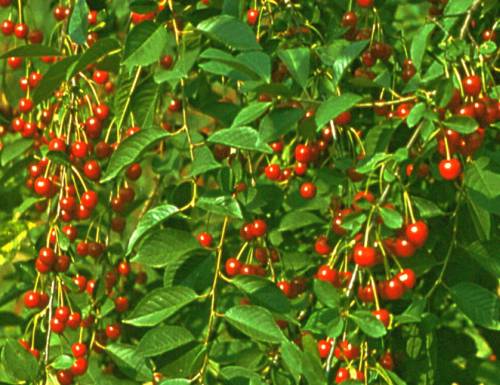

A distinctive feature of this variety is that the seedlings after planting begin to bear fruit already in the second year, and the yield increases every year. Annual branches also bear fruit.
Fruits, in comparison with other varieties, have a darker red color, which can sometimes acquire a brown tint. The fruit of the Apukhtinsky variety is larger than that of an ordinary cherry. Their weight can reach 3.5 g, and in some cases even 4 g. The peculiarity of the fruits of this tree is that they have an unusual heart-shaped shape, and their flesh is very juicy and always looks great. The juice also has an intense dark red hue. Berries contain a lot of free acids and sugar. A medium-sized oval bone is characteristic.
The berries themselves have a tart and sour taste, and sometimes they can give off a slight bitterness. Due to their properties, the fruits are used mainly for the preparation of various jams, preserves and compotes. They turn out to be spicy and unusual in their taste characteristics, which distinguishes the Apukhtinskaya cherry from other types.
Also, this cherry is characterized by a rather long stalk. The separation of ripe fruits from it is easy and dry (there is no violation of the integrity of the skin of the berry and the leakage of juice). But unripe berries are quite problematic to separate.
Apukhtinskaya cherry is a late species that ripens almost at the very end of summer - in August. She also blooms much later, somewhere in early June. Therefore, it cannot be used to pollinate earlier varieties of cherries that already grow in your area.
The variety itself is referred to as self-pollinating, self-fertile. This is due to the peculiarity of the structure of the flower - the height of the stamens with anthers and the height of the pistil are almost the same. Thanks to this, self-pollination is possible even before the flower opens.
The tree can grow from three to seven meters in height. This is its maximum height. But at the same time, such a cherry is quite spreading. Its crown is usually drooping. If desired, it can be made in the form of a bush, which will greatly facilitate harvesting.
Usually, up to ten kilograms of berries can be harvested from one bush or tree of the Apukhtinsky cherry.
This variety has a high degree of resistance to various diseases, but still you should not rely entirely on this, because in rare cases, infection of the tree can still occur. More prone to coccomycosis.
This is a very unpretentious variety in its care. It is recommended for planting in the southwestern and northwestern regions, as it has a satisfactory winter hardiness.
How to choose a cherry for the Moscow region
The capital of Russia and the surrounding areas are characterized by excessive cloudiness, frequent cyclones, and variable atmospheric circulation. As a result of exposure to moderate Atlantic air masses in the region, spring is early or late, summers are hot and humid, and winters are harsh or warm.
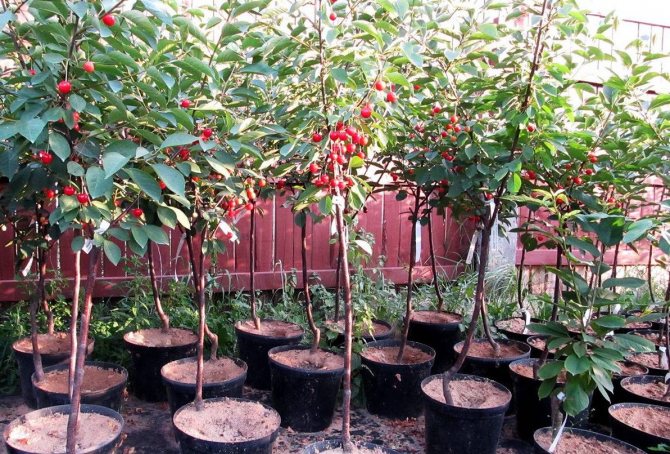

Sharp temperature fluctuations, early cold weather and long winters - all these conditions do not contribute to high yields and early ripening of horticultural crops. Therefore, it is important when buying cherry seedlings to pay attention not only to their quality and freshness, but also to the regional characteristics.
It will be interesting for you to find out which varieties of cherries are best planted in the Moscow region.
Winter hardiness
Winter frosts in the Moscow region often reach -35 ... -38 ° C. And every year in spring, during the flowering period of garden trees, and until mid-June, the night temperature drops to -2 ... - 5 ° C. Such sudden changes and instability of the climate have a detrimental effect on trees that are sensitive to temperature fluctuations.
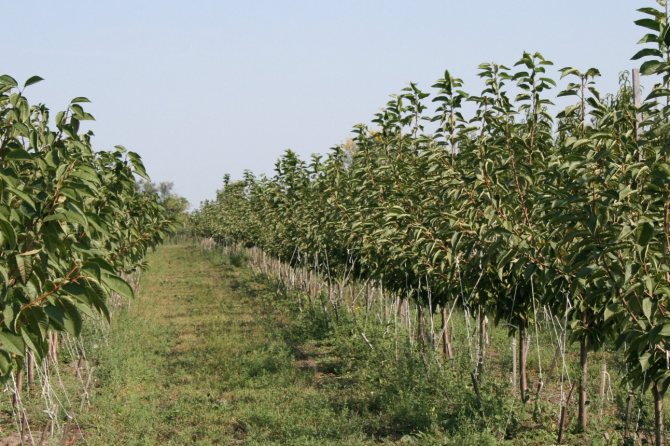

Therefore, for gardeners in this area, the cold resistance of seedlings is of fundamental importance. This quality will help to survive the buds swollen during the thaw, and also, will save flower brushes from the spring subzero temperature.
Disease resistance
Cherries are susceptible to harmful fungal spores, in particular, to the causative agents of coccomycosis, anthracnose, moniliosis, rust, scab, perforated spot, root cancer. The development of pathogenic microflora is facilitated by the variability of the climate of the Moscow region.
Important! To protect early ripe cherries from spring frosts, it is recommended to delay flowering. To do this, shove as much snow as possible into the wells near the trunk, ram it and cover it with light material.
In conditions of constant temperature changes, high humidity, cool summers, frosty and snowless winters, it is difficult for gardeners to deal with plant ailments. Moreover, often the measures taken do not bring the expected results. Hence, highly disease-resistant varieties are preferred for the area.
Self-fertility
Self-pollinated varieties do not require additional pollinators and can independently set up to 60% of berries. The yield can be increased by the successful neighborhood of the culture with simultaneously flowering cherries. If you do not take this criterion into account when choosing seedlings, do not count on a bountiful harvest. Fruiting of self-fertile varieties does not exceed 7% of the total flowering. The indicator is slightly higher in partially self-fertile varieties - up to 20%.
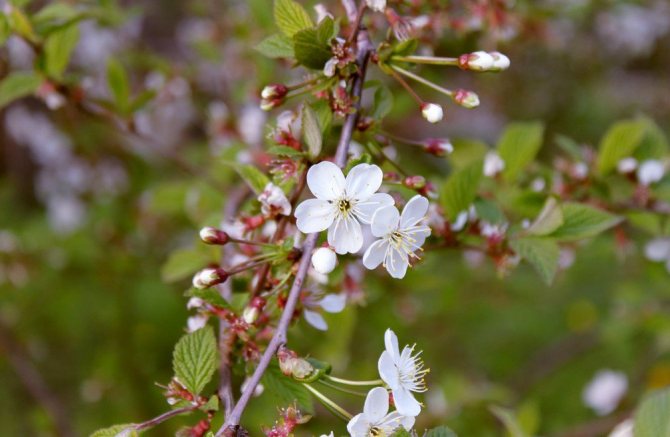

Self-fertile cherry flowers have an unusual structure
Yield
For any climatic zone, high-yielding varieties of cultivated crops are preferred. The average yield of one cherry tree ranges from 16 to 30 kg, depending on their size, variety and age. From one hundred square meters, with the correct planning of planting, you can collect up to 130 kg, and from a hectare - up to 13 tons. Such a number of berries in the Moscow region can be obtained with a non-thickened planting, correct pruning and simple feeding of the cherry orchard.
Did you know? Ancient people used cherries to make food-grade green dyes
.
Tree size
For the Moscow region, undersized varieties are more suitable, which do not give abundant crown growth. On average, their trunk height does not exceed 1.5 m, lateral branches grow no more than 2 cm per year.The length of leaf cuttings is about 4 cm, and their plates can develop up to a maximum of 2.5 cm in length. The berries of such trees are large: in diameter they reach 4-5 cm and each weigh about 5 g.
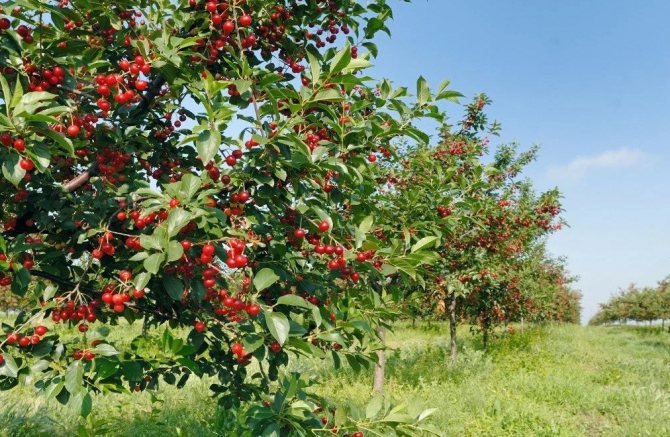

Ripening terms
Among the varietal variety of cherries in the Moscow region, mid-season specimens have proven themselves better. Their vegetative activity begins at a time when spring frosts are no longer threatened.
Did you know? One of the oldest cherries on the planet is a tree growing in the UK. It is more than one and a half hundred years old, and its height reaches 13 m
.
Growing features
This cherry can be easily grown both on farms and in personal plots.
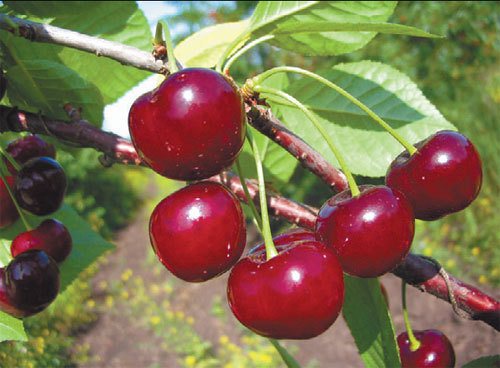

When growing Apukhtinskaya cherry, you need to know the following features:
- pollination with other varieties can significantly increase the yield of the tree;
- to obtain a sufficient level of yield, it is necessary to plant about 5 trees at once;
- the best time for planting is spring;
- one- and two-year-old seedlings are optimal for planting;
- it is necessary to plant seedlings on gentle slopes from the south-west, west and north-west;
- once within 3 years the tree is fertilized with organic fertilizers;
- subject to the introduction of mineral fertilizers and humus into the pit before planting the seedling, during the first years you can not fertilize the cherry;
- the crown can be formed from 2 years old.
The rest of the care is similar to the care of other varieties of this fruit tree.
Cherry Care Video
According to its characteristics, the Apukhtinsky variety is similar to the felt one, so from this video you can glean some information regarding our species.
For all its unpretentiousness in care and due to the taste characteristics of its fruits, the Apukhtinskaya cherry will be a worthy addition to your garden.
The best cherry varieties for the Leningrad region
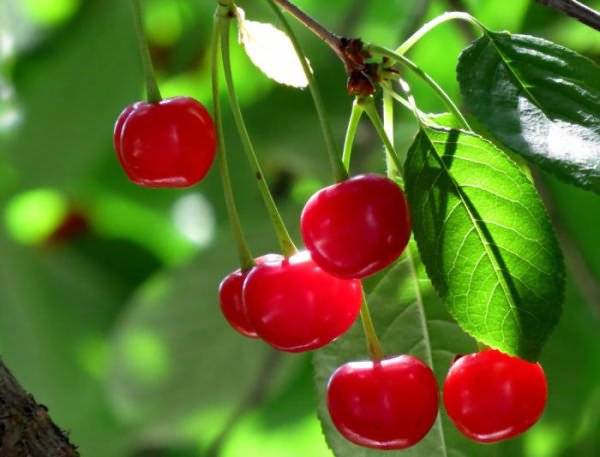

It is difficult to grow cherries in the Northwest. But every year new varieties appear - this densely populated region, fruit crops are in demand. In the Leningrad region, you can grow:
- Altai Swallow;
- Besseya;
- Vladimirskaya;
- Zherdyaevskaya Beauty;
- Desired;
- Star;
- Lyubskaya;
- Frosting;
- Shubinka;
- Ural Ruby.
general characteristics
The cherry tree of the Apukhtinskaya variety got its name from the place of breeding. The variety was created in the village of Apukhtino by a local breeder. The cherry tree has special characteristics:
- is self-fertile;
- flowering occurs relatively late - in early June, so the variety is not used for pollination by a number of growing self-fertile plants;
- has a late ripening of berries - at the end of July;
- cherry belongs to varieties of fast fruiting - as early as 2 years of growth, you can harvest;
- the older the plant, the greater the number of fruits;
- up to 12 kg of harvest can be harvested from one tree.
Cherry variety Apukhtinskaya is resistant to many putrefactive diseases. It has an average resistance to frost and is zoned to the central and southern regions of the country.
Description of the plant
The tree is undersized - up to 3 m, has a wide crown, looks like a shrub. The lower part of the trunk contains 3-4 skeletal branches.
Leaves are medium-sized, oval, slightly pointed, light green in color. The branches are thin and brown in color. The trunk is thin, dark brown in color.
Features of the fetus
Description of the fruits of the Apukhtinskaya variety:
- large in size;
- have a scarlet dark color;
- heart-shaped;
- long stalks that do not interfere with the separation of the berry;
- weight about 4 g.
Cherries have a sour taste. The pulp is red, soft, gives off an abundant amount of juice, the skin is thin. It has a small bone that can be easily separated from the pulp.
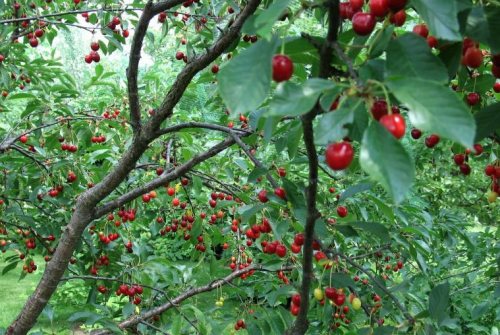

The most common diseases of fruit trees
Fruit trees growing on the territory of the region are very often susceptible to diseases, among which the palm was won by:
- Coccomycosis. It affects the deciduous part - the leaves gradually change color, turn yellow and crumble.
- Moniliosis. It affects the fruits - the cherries are covered with a white bloom and rot.
That is why cherries for the Moscow region should also have increased resistance to these diseases, since cherries can only be removed from them with the help of chemicals, and this will make the fruits unsuitable for human consumption.
Comparing all the necessary characteristics that the best cherry varieties for the Moscow region should have, there are several species among them that feel great in the local climate and are not prone to diseases:
- Lyubskaya cherry;
- Apukhtinskaya cherry;
- Turgenevka;
- Youth cherry.
Growing
Planting a cherry tree should be done in lowlands or slopes.You need to choose a place that is well lit, pay attention so that there is no draft. Planting is carried out in an area where there is no high occurrence of soil water, otherwise the tree will rot and often be exposed to fungal infections.
When planting a cherry tree of the Apukhtinskaya variety, climatic conditions should be taken into account.
- In warm southern regions, planting is carried out both in autumn and spring.
- Regions with a harsh climate require spring planting for better survival of the seedling, providing it with nutrient reserves.
The planting of fruit trees should be carried out at a distance of 3 m from each other in order to ensure normal growth and development of the crown.
Landing
For planting, the preparation of a hole is required, which is dug in dimensions 60 cm deep and 80 cm wide. First, the top layer of the soil, which is fertile, is removed, it is mixed with superphosphate or potassium fertilizers. It should be remembered that nitrogen-containing fertilizers are not applied at this stage of planting, due to the risk of rhizome burns.
- pour a mixture of fertile soil and fertilizer to the middle of the hole in the form of a slide;
- then a stake is driven in, which should be up to half the height of the seedling;
- we place the seedling in the hole, leveling the roots along the perimeter of the embankment;
- fill the hole to the top with a lower layer of soil, the tree should be shaken a little so as not to form voids in the root zone;
- compact the soil, make a furrow at a distance of 0.5 m from the trunk;
- carry out abundant watering with water, about 2 buckets;
- mulch soil with humus.
In order for the Apukhtinskaya cherry variety to grow fertile and become a garden decoration, take care of the correct choice of a seedling in advance. Attention should be paid to the grafting trace, which guarantees the authenticity of the variety.
Take a sprout with multiple branches, in the future this will help in the formation of the crown. The seedling must contain one conductor, otherwise the tree may split into pieces as it matures.
When planting and choosing a seedling, be sure to monitor the integrity of the rhizome. Broken, rotten roots should be removed.
The best cherry varieties for the middle zone and the Chernozem region
Cherry feels comfortable in central Russia. It grows well on black soil at moderate temperatures throughout the year. You should pay attention to the varieties:
- Anthracite;
- Bystrinka;
- Vladimirskaya;
- Griot of Moscow;
- Dessert Morozova;
- Zherdeevskaya Beauty;
- Zhukovskaya;
- Zhivitsa;
- Igritskaya;
- Lebedyanskaya;
- Robin;
- Frosting;
- Novella;
- In memory of Mashkin;
- Gift for Teachers;
- Podbelskaya;
- Putinka;
- Rossoshanskaya;
- Radonezh;
- Spartan woman;
- Turgenevka;
- Kharitonovskaya;
- Cherry;
- Black Large;
- Shubinka;
- Shpanka Bryanskaya.
Separately, I would like to highlight self-fertile cherry varieties for the middle lane:
- Assol;
- Brunette;
- Bulatnikovskaya;
- Volochaevka;
- Dessert Volzhskaya;
- Droplet;
- Lyubskaya;
- Mtsenskaya;
- Youth;
- Mtsenskaya;
- Youth;
- Hope;
- Memory of Yenikeev;
- Tamaris;
- Fairy;
- Farmer;
- Chocolate girl.
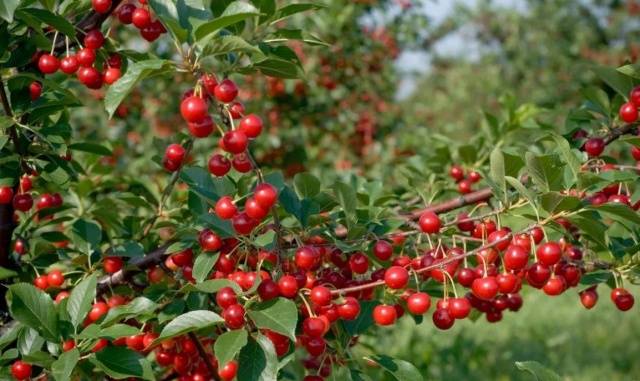

Care features
You should take care of the Apukhtinskaya cherry tree in a timely manner. The health, fertility and appearance of the tree depend on the correct care.
With the arrival of spring, branches are cut to form a crown. Do the procedure until the kidneys swell. Pruning of shoots and pruning of branches that grow vertically are carried out.
Summer care includes mandatory watering, especially during dry periods. Water is brought in buckets into the trunk circle, usually for irrigation it takes as many buckets of water as the plant is old.
Additional watering is required during flowering, fruit development, and preparation for the winter period. After each watering or rain, a place should be dug near the trunk to ensure air flow to the root system, which contributes to the timely drying of the roots and to avoid decay.
In summer, measures should be taken to combat unwanted vegetation, which contributes to the development of diseases and the invasion of harmful insects. During the period of intensive ripening of the crop, it is possible to build supports for the branches so that they do not break from overload.
Diseases and pests
Disease and pest control is an integral part of cherry care.
Diseases
Brown spot is the most common cherry tree disease, with brown spots appearing on the leaves and branches. The infection belongs to the genus of fungi and provokes rapid drying, and subsequently the fall of the leaves. The fight against brown spot is:
- pruning infected areas;
- processing of sections with a solution of copper 100 g per 10 liters.
Coccomycosis leads to the formation of specks on the leaves, which eventually turn into holes. The disease is accompanied by the formation of a pale pink coating on the back of the leaf. Fighting the disease:
- removal of areas affected by coccomycosis;
- irrigation of a tree with a solution of copper sulfate and copper (add 200 g of copper to 10 liters);
- use of the "Horus" preparation: 2 g of the product are taken for 10 liters, the treatment is carried out in 2 stages at intervals of 14 days, after flowering and harvesting the fruits.
Moniliosis is accompanied by the formation of growths on the berries, which are gray. A fungal infection affects branches and leaves, causing them to darken and wilt. Fighting the disease:
- pruning of areas infected with the disease;
- treatment with Bordeaux liquid in a proportion of 10 liters of water per 200 g.
Pests
Aphids are small in size up to 7 mm, but they cause irreparable harm to plants. The presence of aphids is easy to spot by the curled leaves and whitish bloom. The pest feeds on the juice of leaves and branches.
Insect control is a holistic approach that treats all adjacent plants. A soap solution prepared in proportions of 10 liters of warm water to 350 g of grated laundry soap is used against aphids. The tree should be irrigated with a solution within a week.
Fruit mite is a microscopic beetle, reaching a length of 0.5 mm, feeding on the sap of leaves, which leads to their wilting and drying. Lays eggs under the bark of a fruit tree, thereby preserving its offspring. In the fight against ticks, the following are used:
- whitewashing the trunk with lime;
- treatment with "Karbofos" preparation: 10 l of water per 2 g of the preparation, irrigate before flowering.
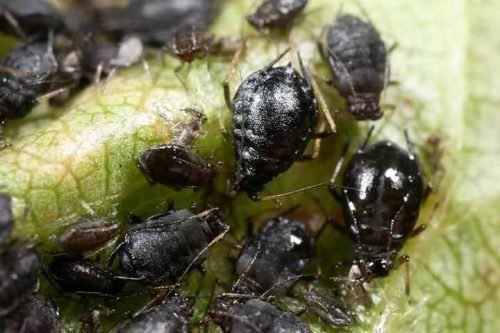

Preventive actions
Prevention will help ensure the growth and development of cherries:
- spring-autumn whitewashing with lime will help to avoid fungal infection and egg-laying pests under the bark;
- pruning done on time will help to avoid brown spot and moniliosis;
- clearing the site from overgrowth and weeds;
- spraying the plant with 1% copper solution.
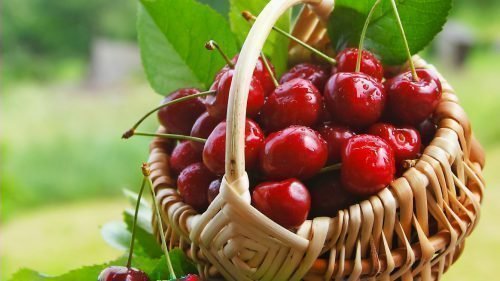

The Apukhtinskaya cherry variety is perfect for growing in the southern and central regions with moderate weather conditions. Good yield indicators, external qualities - make the plant the property of any garden.
The most common diseases of cherries
Disease and pest control is an integral part of cherry care.
Diseases
An important step in growing a tree is combating disease and attacking insects. Effective methods are the use of chemicals. The result is high-quality and durable, but harmful substances are retained in the plant and get into the fruits. It is recommended to use folk methods, their minus is a short period of validity.
Apukhtinskaya cherry is unpretentious and undemanding to care for, so even a beginner can grow it.

